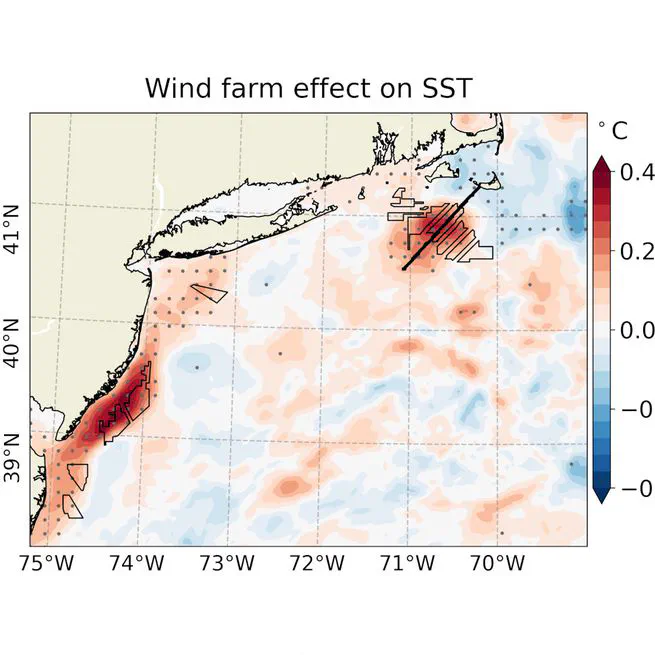
Offshore wind farms may induce changes in the upper ocean and near-surface atmosphere through coupled ocean-atmosphere feedbacks. Yet, the role of air-sea interactions mediated by offshore wind farms remains poorly understood. Using fully coupled ocean-atmosphere-wave model simulations for seasonally stratified conditions along the US East Coast, we show that simulated cumulative reductions in wind stress due to large-scale wind farm clusters lead to sea surface warming of 0.3° to 0.4°C and a shallower mixed layer. This warming drives upward heat fluxes, destabilizing the atmospheric boundary layer and enhancing wind stress, which partially offsets wake-induced wind deficits. These wake-ocean interactions influence near-surface meteorology and air-sea fluxes, suggesting that a coupled modeling approach may be necessary for assessing potential oceanographic impacts of offshore wind developments. However, ocean coupling exerts limited influence on winds at turbine-relevant heights or within downstream wakes, resulting in minimal impact on long-term energy. These findings suggest that models without ocean coupling may be adequate for wind energy applications.
Nov 5, 2025
During a 2023 Lorentz Workshop in Leiden, the Netherlands, a diverse community working in atmospheric and oceanic sciences and in observations and modeling met to discuss emerging ideas and questions on physical air-sea interaction (ASI) processes at the ASI submesoscale, where submesoscale is meant to include both ocean submesoscale and atmosphere mesoscale interactions. This white paper presents a strategy to unravel this emerging research theme, introducing a proposed definition of the ASI submesoscale and a hierarchy of possible interactions, as well as leading challenge questions for different ocean and atmosphere phenomena. It also outlines opportunities to target these questions, inviting the scientific community to take up the challenge to combine efforts across the different disciplines.
Nov 8, 2024
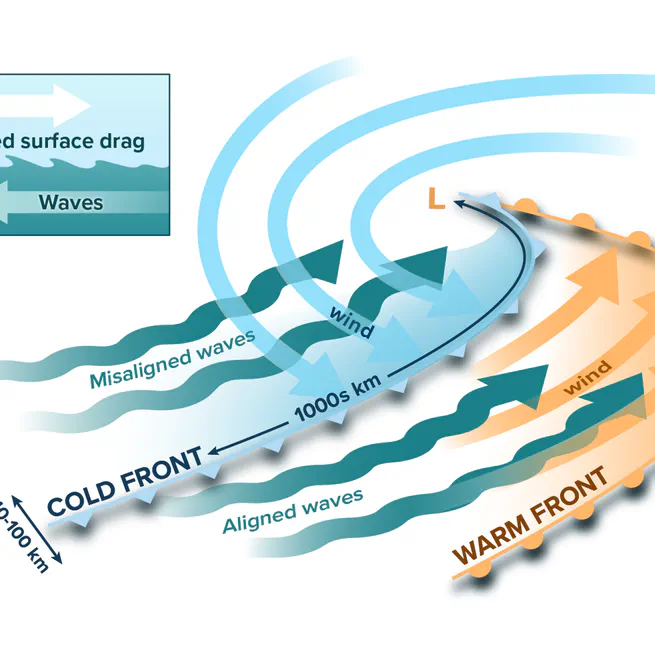
Atmospheric fronts embedded in extratropical cyclones are high-impact weather phenomena, contributing significantly to mid-latitude winter precipitation. The three vital characteristics of the atmospheric fronts, high wind speeds, abrupt change in wind direction, and rapid translation, force the induced surface waves to be misaligned with winds exclusively behind the cold fronts. The effects of the misaligned waves under atmospheric cold fronts on air-sea fluxes remain undocumented. Using the multi-year in situ near-surface observations and direct covariance flux measurements from the Pioneer Array off the coast of New England, we find that the majority of the passing cold fronts generate misaligned waves behind the cold front. Once generated, the waves remain misaligned, on average, for about 8 hr. The parameterized effect of misaligned waves in a fully coupled model significantly increases the roughness length (185%), drag coefficient (19%), and air-sea momentum flux (11%). The increased surface drag reduces the wind speeds in the surface layer. The upward turbulent heat flux is weakly decreased by the misaligned waves because of the decrease in temperature and humidity scaling parameters being greater than the increase in friction velocity. The misaligned wave effect is not accurately represented in a commonly used wave-based bulk flux algorithm. Yet, considering this effect in the current formulation improves the overall accuracy of parameterized momentum flux estimates. The results imply that better representing a directional wind-wave coupling in the bulk formula of the numerical models may help improve the air-sea interaction simulations under the passing atmospheric fronts in the mid-latitudes.
Aug 28, 2024
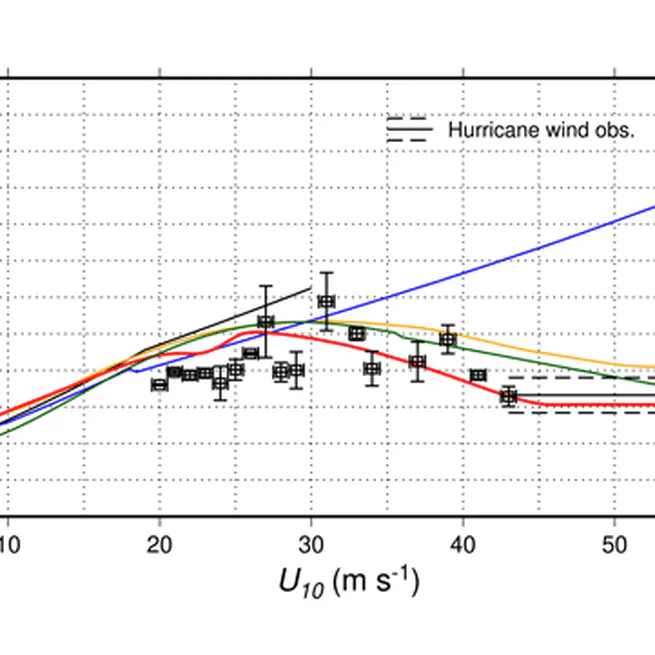
A widely applicable parameterisation of turbulent heat and momentum fluxes at sea has been developed for the SURFEX v8.1 surface model. This wave-age-dependent stress parameterisation (WASP) combines a close fit to available in situ observations at sea up to wind speed of 60 m s−1 with the possibility of activating the impact of wave growth on the wind stress. It aims in particular at representing the effect of surface processes that depend on the surface wind according to the state of the art. It can be used with the different atmospheric models coupled with the surface model SURFEX, including the CNRM-CM climate model, the operational (numerical weather prediction) systems in use at Météo-France, and the research model Meso-NH. Designed to be used in coupled or forced mode with a wave model, it can also be used in an atmosphere-only configuration. It has been validated and tested in several case studies covering different surface conditions known to be sensitive to the representation of surface turbulent fluxes: (i) the impact of a sea surface temperature (SST) front on low-level flow by weak wind, (ii) the simulation of a Mediterranean heavy precipitating event where waves are known to influence the low-level wind and displace precipitation, (iii) several tropical cyclones, and (iv) a climate run over 35 years. It shows skills comparable to or better than the different parameterisations in use in SURFEX v8.1 so far.
Jan 9, 2024
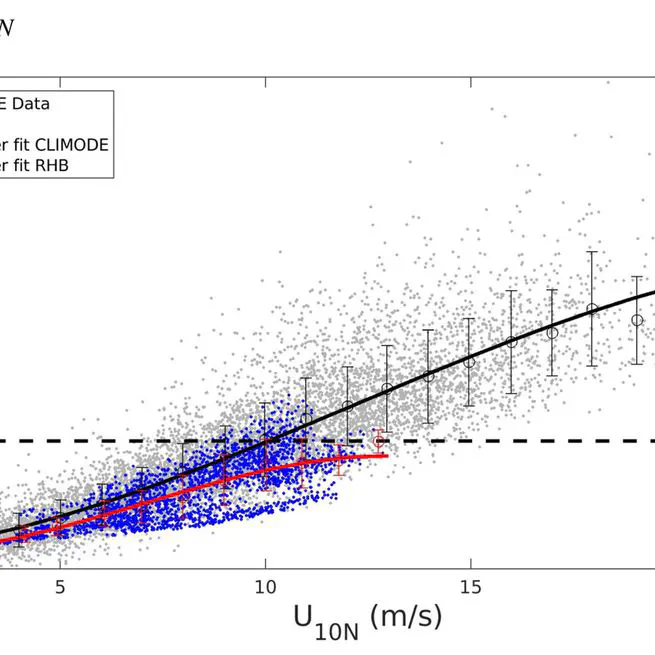
In winter, the Northwest Tropical Atlantic Ocean can be characterized by various wave age-based interactions among ocean current, surface wind and surface waves, which are critical for accurately describing surface wind stress. In this work, coupled wave-ocean-atmosphere model simulations are conducted using two different wave roughness parameterizations within COARE3.5, including one that relies solely on wind speed and another that uses wave age and wave slope as inputs. Comparisons with the directly measured momentum fluxes during the ATOMIC/EUREC4A experiments in winter 2020 show that, for sea states dominated by short wind waves under moderate to strong winds, the wave-based formulation (WBF) increases the surface roughness length in average by 25% compared to the wind-speed-based approach. For sea states dominated by remotely generated swells under moderate to strong wind intensity, the WBF predicts significantly lower roughness length and surface stress (≈15%), resulting in increased near-surface wind speed above the constant flux layer (≈5%). Further investigation of the mixed sea states in the model and data indicates that the impact of swell on wind stress is over-emphasized in the COARE3.5 WBF, especially under moderate wind regimes. Various approaches are explored to alleviate this deficiency by either introducing directional alignment between wind and waves or using the mean wave period instead of the wave period corresponding to the spectral peak to compute the wave age. The findings of this study are likely to be site-dependent, and mostly concern specific regimes of wind and waves where the original parameterization was deficient.
Mar 7, 2023
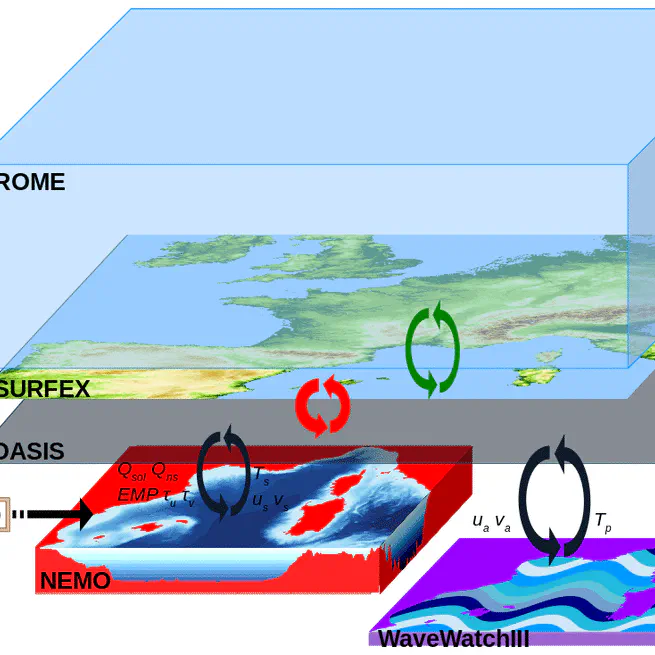
The western Mediterranean Sea area is frequently affected in autumn by heavy precipitation events (HPEs). These severe meteorological episodes, characterized by strong offshore low-level winds and heavy rain in a short period of time, can lead to severe flooding and wave-submersion events. This study aims to progress towards an integrated short-range forecast system via coupled modeling for a better representation of the processes at the air–sea interface. In order to identify and quantify the coupling impacts, coupled ocean–atmosphere–wave simulations were performed for a HPE that occurred between 12 and 14 October 2016 in the south of France. The experiment using the coupled AROME-NEMO-WaveWatchIII system was notably compared to atmosphere-only, coupled atmosphere–wave and ocean–atmosphere simulations. The results showed that the HPE fine-scale forecast is sensitive to both couplings: the interactive coupling with the ocean leads to significant changes in the heat and moisture supply of the HPE that intensify the convective systems, while coupling with a wave model mainly leads to changes in the low-level dynamics, affecting the location of the convergence that triggers convection over the sea. Result analysis of this first case study with the AROME-NEMO-WaveWatchIII system does not clearly show major changes in the forecasts with coupling and highlights some attention points to follow (ocean initialization notably). Nonetheless, it illustrates the higher realism and potential benefits of kilometer-scale coupled numerical weather prediction systems, in particular in the case of severe weather events over the sea and/or in coastal areas, and shows their affordability to confidently progress towards operational coupled forecasts.
Aug 9, 2021
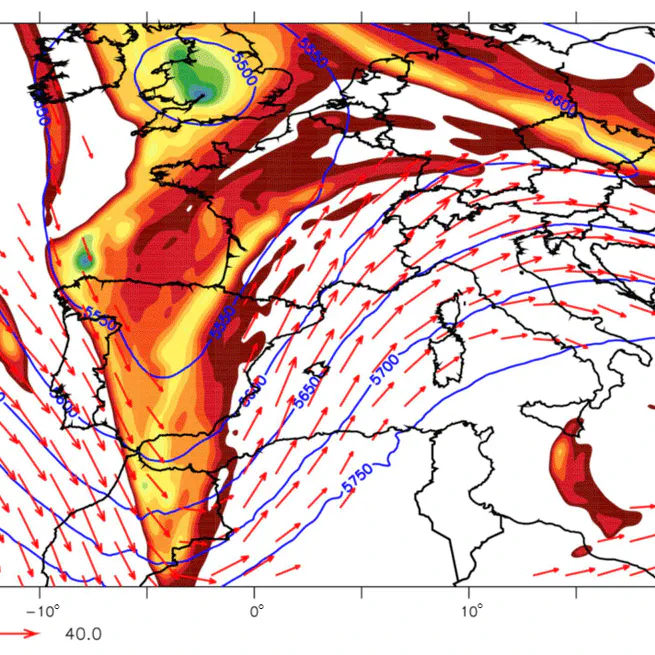
This study investigates the mechanisms acting at the air–sea interface during a heavy precipitation event that occurred between 12 and 14 October 2016 over the north-western Mediterranean area and led to large amounts of rainfall (up to 300 mm in 24 h) over the Hérault region (southern France). The study case was characterized by a very strong (>20 m s−1) easterly to south-easterly wind at low level that generated very rough seas (significant wave height of up to 6 m) along the French Riviera and the Gulf of Lion. In order to investigate the role of the waves on air–sea exchanges during such extreme events, a set of numerical experiments was designed using the Météo-France kilometre-scale AROME-France numerical weather prediction model – including the WASP (Wave-Age-dependant Stress Parametrization) sea surface turbulent flux parametrization – and the WaveWatch III wave model. Results from these sensitivity experiments in the forced or coupled modes showed that taking the waves generated by the model into account increases the surface roughness. Thus, the increase in the momentum flux induces a slowdown of the easterly low-level atmospheric flow and a displacement of the convergence line at sea. Despite strong winds and a young sea below the easterly flow, the turbulent heat fluxes upstream of the precipitating system are not significantly modified. The forecast of the heaviest precipitation is finally modified when the sea state is taken into account; notably, in terms of location, this modification is slightly larger in the forced mode than in the coupled mode, as the coupling interactively balances the wind sea, the stress and the wind.
Feb 11, 2020
The Western Mediterranean Sea area is frequently affected in autumn by heavy precipitation events (HPEs). These episodes, characterized by strong offshore low-level winds and heavy rain in a short period of time, can lead to severe flooding and wave-submersion events. This thesis work aims to progress towards integrated short-range forecast system via coupled modeling for a better representation of the processes at the air-sea interface. The methodology consists in studying the impact of a realistic representation of freshwater flow into the ocean, then examining the impact of better taking into account the sea state, particularly through coupling.In a first part, we evaluated the sensitivity to different river flow representations in the NEMO ocean model during the HyMeX campaign (SOP1, fall 2012). For this purpose, two ocean configurations were used, WMED (1/36°) covering the Western Mediterranean Sea and a new configuration: NWMED (1/72°) covering the Northwestern Mediterranean Sea. Three river discharge forcings are used: a monthly climatology as well as daily and hourly observations. The results showed a significant local impact on the ocean stratification when river discharge observations are used compared to climatology. The surface salinity is modified as well as the mixing layer, becoming thinner, delimited by a well marked halocline. Secondly, we focused on a HPE that occurred between October 12 and 14, 2016 in the south of France. In order to study the role of sea state in air-sea exchanges, a set of numerical simulations was carried out with the Météo-France AROME kilometric atmospheric model - including the turbulent sea surface fluxes parameterization WASP - forced or coupled with the WaveWatchIII wave model. The results showed that taking sea state into account has a significant impact on the lower levels of the atmosphere, reducing the surface wind speed and modifying the precipitation forecast over sea, particularly the location. In the third part of the thesis, we evaluated the contribution of ocean-atmosphere-wavecoupling. In order to identify and quantify the coulping impacts, coupled ocean-atmospherewave simulations were performed using the coupled NEMO-AROME-WaveWatchIII system and notably compared to coupled atmosphere-wave and ocean-atmosphere simulations. The results showed, first of all, that the forecast is sensitive to coupling, and that the interactive coupling with the ocean leads to significant changes in the heat and moisture supply of HPE, while coupling with a wave model mainly leads to changes in the low-level dynamics. These results were finally compared with atmospheric sensitivity tests to the turbulent sea surface fluxes parameterization and to SST. It emerges that the choice of the parameterization can be of great importance for the HPE forecast as large as the coupling with an interactive ocean, whereas the dynamic effect is only produced by considering waves forcing/coupling.
Dec 11, 2019
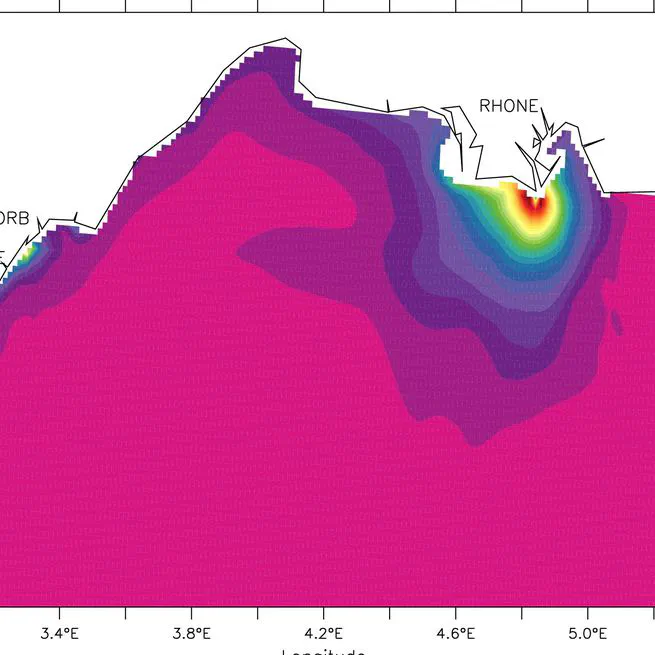
The Western Mediterranean Sea is often affected by heavy precipitation which frequently generates floods or even flash floods. These events generally produce brief but major freshwater inputs in the ocean. In order to evaluate the sensitivity to the representation of river freshwater input, three different runoff forcing dataset are used to drive the NEMO ocean model: a monthly climatology, an observational dataset with a daily or a hourly frequency. The sensitivity is investigated over the first Special Observation Period (SOP1) of the HyMeX program that took place in autumn 2012, in two configurations of NEMO: the first is WMED36 over the Western Mediterranean Sea at 1/36°-resolution and the second is a new configuration covering the North-Western Mediterranean Sea with a 1/72°-resolution named NWMED72. With NWMED72, the impact of the representation of the river freshwater flux, i.e. moving from a surface flux to a vertical distribution of the flux, is also evaluated. The results show that the ocean stratification is significantly modified locally in simulations where runoff observations are used compared to those using the climatology. The sea surface salinity is modified as well as the mixed layer which is thinner as bounded by a well marked halocline. The sea surface temperature is also impacted by the change in runoff frequency. Moreover, the current intensity in river plume during flood is increased. Vertical profiles of salinity and temperature and thus the mixed layer depth are changed when the runoff forcing is distributed over a depth. Those changes are limited and very local but the realism of the river runoff input is improved.
Sep 12, 2018